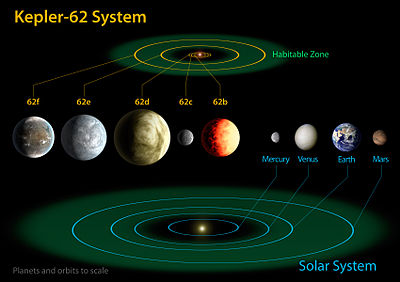Kepler-62
|
Star Kepler-62 |
|||||
|---|---|---|---|---|---|

|
|||||
| Artist's impression of Kepler-62f with Kepler-62 in the background | |||||
| Location of Kepler-62 | |||||
| AladinLite | |||||
|
Observation dates equinox : J2000.0 , epoch : J2000.0 |
|||||
| Constellation | lyre | ||||
| Right ascension | 18 h 52 m 51.06 s | ||||
| declination | + 45 ° 20 ′ 59.5 ″ | ||||
| Typing | |||||
| Known exoplanets | 5 | ||||
| Spectral class | K2 V | ||||
| Astrometry | |||||
| distance | approx. 1200 ly | ||||
| Physical Properties | |||||
| Dimensions | (0.69 ± 0.02) M ☉ | ||||
| radius | (0.64 ± 0.02) R ☉ | ||||
| Effective temperature | (4925 ± 70) K. | ||||
| Metallicity [Fe / H] | −0.209 | ||||
| Age | 7 ± 4 billion a | ||||
|
Other names and catalog entries |
|||||
|
|||||
Kepler-62 is a star of the spectral class K2V in the constellation Lyra , 1200 light-years from Earth. It is slightly colder than the Sun and has at least five exoplanets orbiting it.
Planetary system
On April 18, 2013, researchers at the Kepler Telescope announced that the star has five planets. All of them were discovered using the transit method: seen from Earth, the planets pass in front of their star once per orbit. This leads to a difference in brightness, which is measured by the Kepler telescope. The masses of the planets could not yet be measured, so only very rough upper limits are known.
The two outermost planets, Kepler-62e and Kepler-62f , could be Earth-like and have rocks and liquid water on their surface. Some scientists even suspect that they could be so-called ocean planets .
| planet | Mass (in earth masses) |
Radius (in earth radii) |
Density (g / cm 3 ) |
Cycle time (days) |
Semi-major axis ( AE ) |
Orbit inclination ( degree ) |
|---|---|---|---|---|---|---|
| b | <9 | 1.31 ± 0.04 | ? | 5.71493 | 0.0553 | 89.2 ± 0.4 |
| c | <4 | 0.54 ± 0.03 | ? | 12.4417 | 0.0929 | 89.7 ± 0.2 |
| d | <14 | 1.95 ± 0.07 | ? | 18.16406 | 0.120 | 89.7 ± 0.3 |
| e | <36 | 1.61 ± 0.05 | ? | 122.3874 | 0.427 | 89.98 ± 0.02 |
| f | <35 | 1.41 ± 0.07 | ? | 267.291 | 0.718 | 89.90 ± 0.03 |
Web links
Individual evidence
- ↑ Simbad
- ↑ Kepler Input Catalog (2009)
- ↑ a b William J. Borucki, et al. : Kepler-62: A Five-Planet System with Planets of 1.4 and 1.6 Earth Radii in the Habitable Zone . In: Science Express . April 18, 2013. doi : 10.1126 / science.1234702 .
- ↑ Welt ohne Land from Der Spiegel , accessed on April 6, 2014

